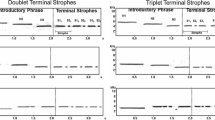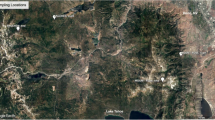Abstract
Many bird species, especially song birds but also for instance some hummingbirds and parrots, have noted dialects. By this we mean that locally a particular song is sung by the majority of the birds, but that neighbouring patches may feature different song types. Behavioural ecologists have been interested in how such dialects come about and how they are maintained for over 45 years. As a result, a great deal is known about different mechanisms at play, such as dispersal, assortative mating and learning of songs, and there are several competing hypotheses to explain the dialect patterns known in nature. There is, however, surprisingly little theoretical work testing these different hypotheses at present. We analyse the simplest kind of model that takes into account the most important biological mechanisms, and in which one may speak of dialects: a model in which there are but two patches, and two song types. It teaches us that a combination of little dispersal and strong assortative mating ensures dialects are maintained. Assuming a simple, linear frequency-dependent learning rule has little effect on the maintenance of dialects. A nonlinear learning rule, however, has dramatic consequences and greatly facilitates dialect maintenance. Adding fitness benefits for singing particular songs in a given patch also has a great impact. Now rare song types may invade and remain in the population.







Similar content being viewed by others
References
Appleby BM, Redpath SM (1997) Indicators of male quality in the hoots of tawny owls (Strix aluco). J Raptor Res 31:65–70
Baker MC (2003) Local similarity and geographic differences in a contact call of the galah (Cacatua roseicapilla assimilis) in Western Australia. Emu 103:233–237
Baker MC, Cunningham MA (1985) The biology of bird-song dialects. Behav Brain Sci 8:85–133
Baker MC, Spitler-Nabors KJ, Thompson ADJ, Cunningham MA (1987) Reproductive behaviour of female white-crowned sparrows: effect of dialects and synthetic hybrid songs. Anim Behav 35:1766–1774
Baptista LF, Boarman WI, Kandianidis P (1983) Behavior and taxonomic status of Grayson’s dove. Auk 100:907–919
Baptista LF, King JR (1980) Geographical variation in song and song dialects of the montane white-crowned sparrow. Condor 82:267–284
Baptista LF, Petrinovich L (1984) Social interaction, sensitive phases and the song template hypothesis in the white-crowned sparrow. Anim Behav 32:172–181
Bell DA, Trail PW, Baptista LF (1998) Song learning and vocal tradition in Nuttall’s white-crowned sparrows. Anim Behav 55:939–956
Borror DJ (1956) Variation in Carolina Wren songs. Auk 73:211–229
Boyd R, Richardson PJ (1985) Culture and the evolutionary process. Chicago University Press, Chicago
Camazine S, Deneubourg J-L, Franks NR, Sneyd J, Theraulaz G, Bonabeau E (2001) Self-organization in biological systems. Princeton University Press, Princeton
Catchpole C, Slater B (1995) Bird song: biological themes and variations. Cambridge University Press, Cambridge
Cunningham MA, Baker MC, Boardman TJ (1989) Microgeographic song variation in the Nuttall’s white-crowned sparrow. Condor 89:261–275
Derryberry EP (2011) Male response to historical and geographical variation in bird song. Biol Lett 7:57–59
Dingle C, Halfwerk W, Slabbekoorn H (2008) Habitat-dependent song divergence at subspecies level in grey-breasted wood-wren. J Evol Biol 21:1079–1089
Dingle C, Poelstra JW, Halfwerk W, Brinkhuizen DM, Slabbekoorn H (2010) Asymmetric response patterns to subspeciesspecific song differences in allopatry and parapatry in the gray-breasted wood-wren. Evolution 64:3537–3548
Edwards SV, Kingan SB, Calkins JD, Balakrishnan CN, Jennings WB, Swanson WJ, Sorenson MD (2005) Speciation in birds: genes, geography, and sexual selection. Proc Nat Acad Sci 102:6550–6557
Ellers J, Slabbekoorn H (2003) Song divergence and male dispersal among bird populations: a spatially explicit model testing the role of vocal learning. Anim Behav 65:671–681
Gaunt SLL, Baptista LF, Sánchez JE, Hernández D (1994) Song learning as evidenced from song sharing in two hummingbird species (Colibri coruscans and C. thalassinus). Auk 111:87–103
Goldstein RB (1978) Geographic variation in Hoy call of Bobwhite Colinus virginianus. Auk 95:85–94
Grant BR, Grant PR (1996) Cultural inheritance of song and its role in the evolution of Darwinś finches. Evolution 50:2471–2487
Handford P (1988) Trill rate dialects in the rufous-collared sparrow, Zonotrichia capensis, in north-western Argentina. Can J Zool 66:2658–2670
Harbison H, Nelson DA, Hahn TP (1999) Longterm persistence of song dialects in the mountain whitecrowned sparrow. Condor 101:133–148
Kroodmsa DE (1985) Goegraphic variation in songs of the Bewicks Wren complex: a search for correlations with avifaunal complexity. Behav Ecol Sociobiol 16:143–150
Kroodsma DE (1974) Song learning, dialects and dispersal in the Bewicks wren. Z. für Tierpsychologie 35:352–380
Kroodsma DE (2004) The diversity and plasticity of birdsong. In: Marler P, Slabbekoorn H (eds) Nature’s Music. Elsevier Academic Press, Amsterdam, pp 108–131
Kroodsma DE, Liu WC, Goodwin E, Bedell PA (1999) The ecology of song improvisation as illustrated by North American Sedge Wrens. Auk 116:373–386
Lachlan R, Slater PJB (1999) The maintenance of vocal learning by gene-culture interaction: the cultural trap hypothesis. Proc Roy Soc London B 266:701–706
Lachlan RF, Janik VM, Slater PJB (2004) The evolution of conformity-enforcing behaviour in cultural communication systems. Anim Behav 68:561–570
Lachlan RF, Servedio MR (2004) Song learning accelerates allopatric speciation. Evolution 58(9): 2049–2063
Lachlan RF, Slater PJB (2003) Song learning by chaffinches: how accurate, and from where? Anim Behav 65:957–969
Luther D, Baptista LF (2010) Urban noise and the cultural evolution of bird songs. Proc Roy Soc London B 277:469–473
MacDougall-Shackleton EA, Derryberry EP, Hahn TP (2002) Nonlocal male mountain white-crowned sparrows have lower paternity and higher parasite loads than males singing local dialect. Behav Ecol 13:682–689
Marler P (1970) A comparative approach to vocal learning: song development in white-crowned sparrows. J Comp Physiol Psychol 71:1–25
Marler P, Peters S (1982) Developmental overproduction and selective attrition: new processes in the epigenesis of birdsong. Dev Psychiobiol 15:369–378
Marler P, Slabbekoorn H (2004) Nature’s music. Elsevier Academic Press, Amsterdam
Marler P, Tamura M (1962) Song “dialects” in three populations of white-crowned sparrows. Condor 64:368–377
McGregor PK, Krebs JR (1989) Song learning in adult great tits (Parus major): effect of neighbours. Behaviour 108:139–159
Mountjoy DE, Lemon RE (1995) Extended song learning in wild European starlings. Anim Behav 49: 357–366
Mundinger PC (1982) Microgeographic and macrogeographic variation in the acquired vocalizations of birds. In: Kroodsma DE, Miller EH, Quellet H (eds) Acoustic communication in birds, vol I. Academic Press, New York, pp 147–208
Murray JD (2003) Mathematical biology II: spatial models and biomedical applications. Springer, Berlin
Nelson DA (1992) Song overproduction and selective attrition lead to song sharing in the field sparrow (Spizella pusilla). Behav Ecol Sociobiol 30:415–424
Nelson DA (2000) Song overproduction, selective attrition, and song dialects in the white-crowned sparrow. Anim Behav 60:887–898
Nelson DA, Hallberg KI, Soha JA (2004) Cultural evolution of Puget Sound white-crowned sparrow song dialects. Ethology 110:879–908
Nelson DA, Khanna H, Marler P (2001) Learning by instruction or selection: implications for patterns of geographic variation in bird song. Behaviour 138:1137–1160
Nelson DA, Marler P, Morton ML (1996) Overproduction in song development: an evolutionary correlate with migration. Anim Behav 51:1127–1140
Nottebohm F, Nottebohm ME (1978) Relationship between song repertoire and age in the canary, Serinus canarius. Z. für Tierpsychologie 46:298–305
Payne RB (1978) Microgeographic variation in songs of the splendid sunbird Nectarinia coccinigaster: population phenetics, habitats, and song dialects. Behaviour 65:282–308
Payne RB (1981) Song learning and social interaction in indigo buntings. Anim Behav 29:688–697
Peake TM, McGregror PK (1999) Geographical variation in the vocalization of the corn crake Crex crex. Ethol Ecol Evol 11:123–137
Podos J, Warren PS (2007) The evolution of geographic variation in birdsong. Adv Study Behav 37:403–458
Price T (2008) Speciation in birds. Roberts and Company, Greenwood Village
Rivera-Gutierrez HF, Matthysen E, Adriaensen F, Slabbekoorn H (2010) Repertoire sharing and song similarity between great tit males decline with distance between forest fragments. Ethology 116: 951–960
Slabbekoorn H, Jesse A, Bell D (2003) Microgeographic song variation in island populations of the white-crowned sparrow (Zonotrichia leucophrys nutalli): innovation through recombination. Behaviour 140:947–963
Slabbekoorn H, Peet M (2003) Birds sing at higher pitch in urban noise. Nature 424:267
Slabbekoorn H, Smith TB (2002) Bird song, ecology and speciation. Proc Roy Soc London B 357:493–503
Strigul N (2009) Can imitation explain dialect origins? Ecol Model 220:2624–2639
Williams JM, Slater PJB (1990) Modelling bird song dialects: the influence of repertoire size and number of neighbours. J Theor Biol 145:487–496
Wright TF (1996) Regional dialects in the contact call of a parrot. Proc Roy Soc London B 263:867–872
Yang X-J, Lei F-M, Wang G, Jesse AJ (2007) Syllable sharing and inter-individual syllable variation in Anna’s hummingbird Calypte anna songs, in San Francisco. California Folia Zool 56:307–318
Zann R (1997) Vocal learning in wild and domesticated zebra finches: signature cues for kin recognition or epiphenomena? In: Snowdon CT, Hausberger M (eds) Social influences on vocal development. Cambridge University Press, Cambridge, pp 85–97
Author information
Authors and Affiliations
Corresponding author
Rights and permissions
About this article
Cite this article
Planqué, R., Britton, N.F. & Slabbekoorn, H. On the maintenance of bird song dialects. J. Math. Biol. 68, 505–531 (2014). https://doi.org/10.1007/s00285-012-0632-8
Received:
Revised:
Published:
Issue Date:
DOI: https://doi.org/10.1007/s00285-012-0632-8




